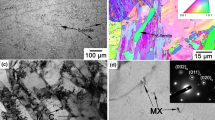Abstract
A study of the influence of carbide phases on the cracking resistance of as-quenched and of quenched and tempered 0.5 pct Mo-B steels was made using notched or notched and precracked specimens that were subjected to impact, cyclic, and monotonically increasing loading. The carbide influence on fracture, while limited in extent, was found to increase as load, loading rate, volume fraction, and particle size increase. The results for the asquenched condition showed that the susceptibility of these steels to crack initiation under impact loading at temperatures below - 100°F is greater when even a small amount of titanium carbide (less than 0.2 vol pet of 1 to 5 μm particles) is present than when none is present. At room temperature, this same carbide concentration has no influence on impact properties, fatigue-crack initiation (in the presence of a notch), fatigue-crack growth rate, or the ductile fracture resistance under monotonically increasing loading at slow strain rate. In the case of the quenched and tempered materials, the alloy containing a large amount of M23C6 (2 vol pct of 1 to 10 μm particles) exhibited behavior similar to that observed in the as-quenched materials containing titanium carbide. That is, the presence of M23C6 was associated with increased susceptibility to crack initiation for impact loading at low temperature. In addition, at room temperature this alloy had a reduced impact energy for crack propagation. For monotonically increasing loading at slow strain rate, this same carbide distribution had no influence on the net section stresses required to initiate stable or unstable crack growth. These stresses fall closely in line with, respectively, the yield stress and tensile strength of the material. The alloy containing M23C6 required less crack opening for a given crack extension—an effect most pronounced after maximum load. Finally, some attention is directed to the use of Charpy test data to assess fracture resistance for modes of loading other than impact.
Similar content being viewed by others
References
J. M. Hodge, R. H. Frazier, and F. W. Boulger:Trans. TMS-AIME, 1959, vol. 215, p. 749.
G. E. Gazza and F. R. Larson:Trans. ASM, 1964, vol. 58, p. 183.
R. M. N. Pelloux:Trans. ASM, 1964, vol. 57, p. 511.
A. J. Birkle, R. P. Wei, and G. E. Pellissier:Trans. ASM, 1966, vol. 59, p. 981.
C. J. Mahon, Jr. and M. Cohen:Acta Met., 1965, vol. 13, p. 591.
N. P. Allen, W. P. Rees, B. E. Hopkins, and H. R. Tipler:J. Iron Steel Inst., 1953, vol. 174, p. 108.
W. Jolley:J. Iron Steel Inst., 1968, vol. 206, p. 170.
G. H. Karchner and E. T. Stephenson:Trans. ASM, 1968, vol. 61, p. 457.
J. T. Barnby and F. M. Pece:Acta Met., 1971, vol. 19, p. 1351.
G. H. Karchner: Homer Research Laboratories, Bethlehem Steel Corp., private communication.
Metals Handbook, p. 448, ASM, Cleveland, Ohio, 1948.
G. A. Miller:Trans. ASM, 1968, vol. 61, p. 442.
W. F. Brown and J. E. Srawley:Plane Strain Crack Toughness Testing of High Strength Metallic Materials, p. 26, ASTM STP-410, 1967.
F. B. Pickering:Precipitation Processes during the Tempering of Martensitic Alloy Steels, BISI Special Report No. 64, 1959.
J. M. Barsom and S. T. Rolfe:Impact Testing of Metals, p. 281, ASTM STP-466, 1970.
Author information
Authors and Affiliations
Rights and permissions
About this article
Cite this article
Miller, G.A., Stephenson, E.T. The effect of the carbide phases on the crack grow of 0.5 pct Mo-B steels under impact, cyclic, and monotonically increasing loading. Metall Trans 5, 659–666 (1974). https://doi.org/10.1007/BF02644662
Received:
Published:
Issue Date:
DOI: https://doi.org/10.1007/BF02644662




